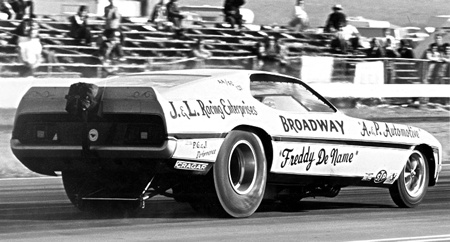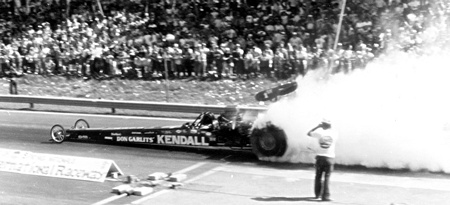 |
 |
|
The one and only "Broadway Freddy" DeName, New York Funny Car
match racer frequently competing at the AHRA Nationals in New
York and in court as an alledged soldier in the late Roy Demeo's
Brooklyn hit crew.
Photo by Steve Reyes.
|
Given the heavy losses of 1973, AHRA needed re-financing and went for
it in 1974. Since 1970 the younger Tice had headed his father's Motorsports
Cuisine, a concessions business that he operated at most of the AHRA
national event sites and at other venues. The senior Tice sold his company
for a million dollars and with that money and some other financing,
he and his son got the organization in running order again. And the
organization needed the infusion, because NHRA and IHRA were starting
to distance themselves from AHRA with the big financial assists they
got from Winston. Television and major corporate backing truly changed
the drag racing landscape and it upped the ante for everybody.
AHRA's method for staying afloat in its last 10 years of existence
was its continued practice of buying in the race stars. They knew that
a Garlits, Prudhomme, Bill Jenkins or some similar talent meant, as
Tice Jr., put it, "butts on the boards." They may not have been able
to match the dollars that were being pumped into the NHRA / IHRA coffers
at the time, but they did have tools at their disposal to insure some
profits.
"That's the way we negotiated with the racers," said Tice. "If you
were a local pro racer without much national exposure, we couldn't give
you as much as a Garlits or Prudhomme. In the late 1970's, we downsized
our pro shows to eight-car fields and of those eight, we'd buy in probably
half the cars."
 |
The inimitable Don Garlits
does a burnout at the 1983 AHRA Grand American at Tulsa. |
The formula worked well enough. The AHRA shows of the late 1970's held
up well at the gate. As one example, the 1978 Grand American at Dragway
42 in West Salem, Ohio featured an eight-car Top Fuel field that consisted
of Don Garlits, Frank Bradley, Jerry Ruth, Jeb Allen, Gary Beck, Clayton
Harris, Paul Longenecker, and Mark Howick. The Funny Car clan was represented
by Don Prudhomme, Tom McEwen, Tom Hoover, Gene Snow, Johnny Loper's
"Little Hoss" Arrow with Tripp Shumake up, Stan Bowman's "Ohio State
Patrol" Camaro, John Collins' Pioneer Stereo Pontiac, and "Poncho" Rendon's
"Detroit Tiger" Monza with Tom Prock driving. That was quality entertainment
and on a par with NHRA and IHRA. The big difference, though, was that
NHRA and IHRA gave the fans 16 cars per pro field, better venues, and
better exposure, both in the electronic and print mediums.
 |
page 2 of 6
|
|
|
|
|
| |

Champion
is offering you the opportunity to be part of its winning team. This offer
is extended to competitors and members of the motorsports community who
use and support Champion ignition products. This
membership includes:
Member
Discounts
Club Newsletter
Decals
Patches
Racing News
Results We
are very interested in your competive results and your history with Champion
products, and welcome any submissions about these subjects.  | |
|
|
|